Recently published
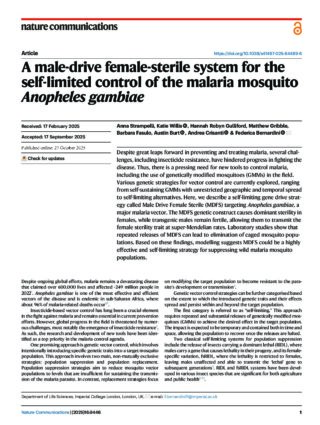
Publication – November 11, 2025
A male-drive female-sterile system for the self-limited control of the malaria mosquito Anopheles gambiae
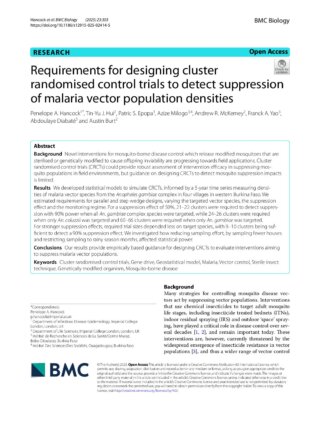
Publication – November 11, 2025
Requirements for designing cluster randomised control trials to detect suppression of malaria vector population densities

Publication – November 27, 2024
Unravelling the role of mitochondrial DNA in hybrid incompatibility within species of the Anopheles gambiae complex
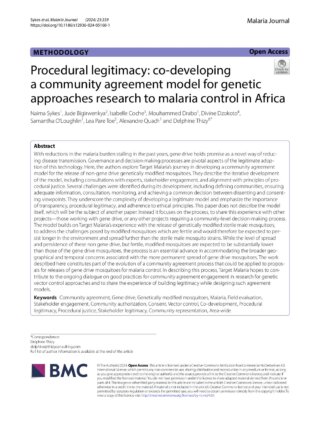
Publication – November 26, 2024
Procedural legitimacy: co-developing a community agreement model for genetic approaches research to malaria control in Africa
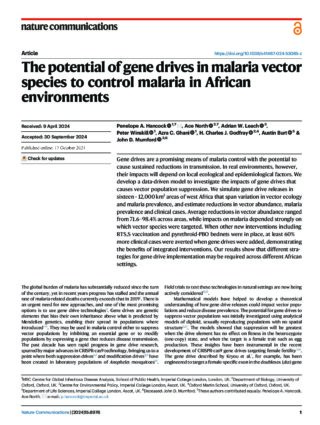
Publication – October 17, 2024
The potential of gene drives in malaria vector species to control malaria in African environments

Publication – September 23, 2024
Whole-genome sequencing of major malaria vectors reveals the evolution of new insecticide resistance variants in a longitudinal study in Burkina Faso

Publication – June 12, 2024
A review of applications and limitations of using aquatic macroinvertebrate predators for biocontrol of the African malaria mosquito, Anopheles gambiae sensu lato
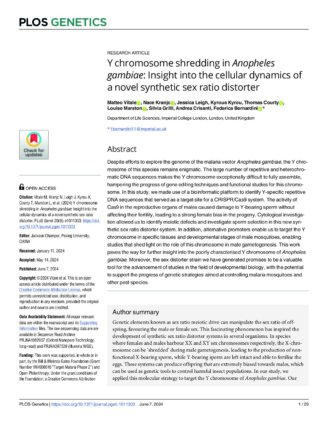
Publication – June 07, 2024
Y chromosome shredding in Anopheles gambiae: Insight into the cellular dynamics of a novel synthetic sex ratio distorter

Publication – March 21, 2024
Attributes of Anopheles gambiae swarms in South Central Uganda
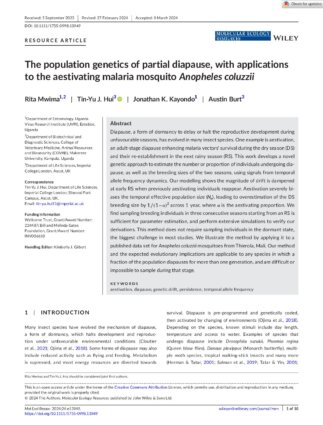
Publication – March 21, 2024
The population genetics of partial diapause, with applications to the aestivating malaria mosquito Anopheles coluzzii
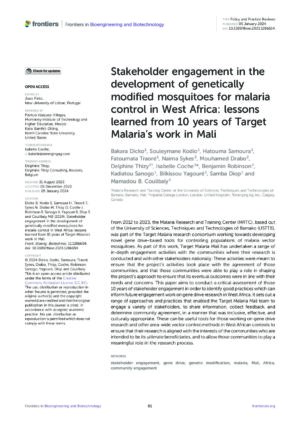
Publication – January 05, 2024
Stakeholder engagement in the development of genetically modified mosquitoes for malaria control in West Africa: lessons learned from 10 years of Target Malaria’s work in Mali
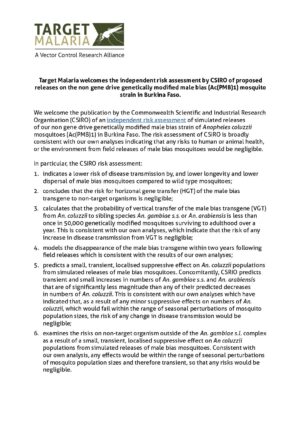
Publication – November 14, 2023
CISRO risk assessment on male bias (Ac(PMB)1) in Burkina Faso

Publication – November 07, 2023
Potential persistence mechanisms of the major Anopheles gambiae species complex malaria vectors in sub-Saharan Africa: a narrative review

Publication – August 14, 2023
Bioinformatic and literature assessment of toxicity and allergenicity of a CRISPR-Cas9 engineered gene drive to control Anopheles gambiae the mosquito vector of human malaria
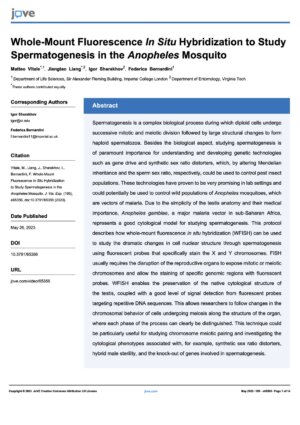
Publication – May 26, 2023
Whole-Mount Fluorescence In Situ Hybridization to Study Spermatogenesis in the Anopheles Mosquito
Publication – May 09, 2023
Considerations for Rearing and Maintaining Anopheles in the Laboratory
Publication – May 09, 2023
Anopheles Adult Anesthesia, Feeding, and Sex Separation
Publication – May 09, 2023
Anopheles Egg Collection, Disinfection, and Hatching
Publication – May 09, 2023
Anopheles Larval Rearing
Publication – April 12, 2023
Defining transformation events for gene drive in species complexes
Publication – April 12, 2023
Assessment tools for decision making for area wide malaria vector control using gene-drive approaches – perspectives on socioeconomic considerations
Publication – March 14, 2023
Standing genetic variation and chromosome differences drove rapid ecotype formation in a major malaria mosquito
Publication – February 24, 2023
Engagement on risk assessment for gene drive mosquitoes by EFSA and Target Malaria
Publication – January 13, 2023
Effects of storage conditions and digestion time on DNA amplification of biting midge (Culicoides) blood meals
Publication – December 27, 2022
Gene drive designs for efficient and localisable population suppression using Y-linked editors
Publication – December 14, 2022
WHO World malaria report 2022
Publication – November 24, 2022
Analysis of the Genetic Variation of the Fruitless Gene within the Anopheles gambiae (Diptera: Culicidae) Complex Populations in Africa
Publication – October 16, 2022
Driving down malaria transmission with engineered gene drives
Publication – October 16, 2022
Introgression of a synthetic sex ratio distortion transgene into different genetic backgrounds of Anopheles coluzzii
Publication – October 16, 2022
Points to consider in seeking biosafety approval for research, testing, and environmental release of experimental genetically modified biocontrol products during research and development
Publication – August 23, 2022
A theory of resistance to multiplexed gene drive demonstrates the significant role of weakly deleterious natural genetic variation
Publication – August 05, 2022
Spatial modelling of malaria prevalence associated with geographical factors in Houet province of Burkina Faso, West Africa
Publication – July 01, 2022
Operationalizing stakeholder engagement for gene drive research in malaria elimination in Africa – translating guidance into practice
Publication – July 01, 2022
Gene drive in species complexes: defining target organisms
Publication – July 01, 2022
Comprehensive characterization of a transgene insertion in a highly repetitive, centromeric region of Anopheles mosquitoes

